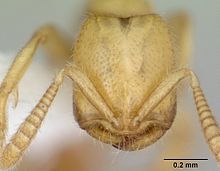Adetomyrma venatrix
| Adetomyrma venatrix | |
|---|---|

| |
| A blind worker | |

| |
| A winged queen | |
| Scientific classification | |
| Kingdom: | |
| Phylum: | |
| Class: | |
| Order: | |
| Family: | |
| Subfamily: | |
| Tribe: | |
| Genus: | |
| Species: | A. venatrix
|
| Binomial name | |
| Adetomyrma venatrix | |
Adetomyrma venatrix, more commonly known as the Dracula ant, so named because of its grisly feeding habits of drinking the blood of its young, is an endangered species of ants endemic to Madagascar. Workers of this species are blind. The species was described as the type species of Adetomyrma in 1994, with the genus being an atypical member of its tribe.
Description

Adetomyrma venatrix was described on the basis of specimens belonging to the worker caste collected from Zombitse Forest, in western Madagascar. The key characteristics of the species was the absence of a clear petiole when viewed from above due to the third abdominal tergite (the sclerite on the dorsal side) lacking a differentiated pretergite. The gaster is large and without constrictions. The ant is blind and has a long sting. It was placed with reservations in the tribe Amblyoponini as it lacks the typical characters of the group.[3] Later studies considered them as being close to the ancestral members of the Amblyoponinae and they share certain morphological features with Amblyopone pluto such as the presence of laterosclerite.[4][5]
References
- ^ Social Insects Specialist Group (1996). "Adetomyrma venatrix". The IUCN Red List of Threatened Species. 1996. IUCN: e.T522A13059247. doi:10.2305/IUCN.UK.1996.RLTS.T522A13059247.en. Retrieved 11 January 2018.
- ^ Ward, P. S. (1994). "Adetomyrma, an enigmatic new ant genus from Madagascar (Hymenoptera: Formicidae), and its implications for ant phylogeny" (PDF). Systematic Entomology. 19 (2): 159–175. doi:10.1111/j.1365-3113.1994.tb00585.x.
- ^ Fisher, BL (1997). "Biogeography and ecology of the ant fauna of Madagascar (Hymenoptera: Formicidae)" (PDF). Journal of Natural History. 31 (2): 269–302. doi:10.1080/00222939700770141.
- ^ Perrault, Gérard H. (2004). "Étude morphoanatomique et biométrique du métasoma antérieur des ouvrières. Contribution à la systématique et à la phylogénie des fourmis (Hymenoptera : Formicidae)" (PDF). Ann. Soc. Entomol. Fr. (in French). 40 (3–4): 291–371. doi:10.1080/00379271.2004.10697428.
- ^ Grimaldi, D; D Agosti; J M Carpenter. "New and Rediscovered Primitive Ants (Hymenoptera: Formicidae) in Cretaceous Amber from New Jersey, and Their Phylogenetic Relationships" (PDF). American Museum Novitates. 3208: 1–43.
External links
 Media related to Adetomyrma venatrix at Wikimedia Commons
Media related to Adetomyrma venatrix at Wikimedia Commons- dracula-ant/adetomyrma-venatrix Adetomyrma venatrix media from ARKive

